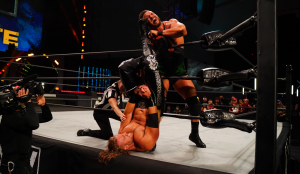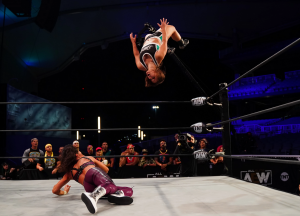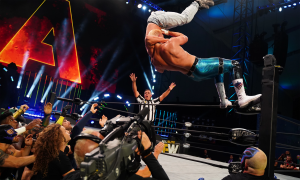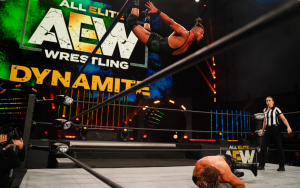All Elite Wrestling Stays Big and Loud Even in the Pandemic
A complex and boisterous show keeps its production crew busy
Story Highlights
If All Elite Wrestling didn’t exist, Netflix would have had to invent it. A dramedy that combines the pugilistic athleticism of all three Stooges with plot lines worthy of a Mexican telenova and characters straight out of a Marvel comics tentpole, AEW Dynamite hit the road last year as a touring and televised show, its elaborate sets and AVL technology underscored by the 13 trucks and 92 crewmembers needed to haul, pitch, and put on the bombastic production from city to city.
However, the COVID pandemic brought those trucks to a halt in March, and, after a brief stop for a few shows taped at the company’s training facility — the Nightmare Factory in Norcross, GA — AEW instead set up shop in May at Daily’s Place, a three-year-old 5,500-seat amphitheater in Jacksonville, FL. (It’s next door to TIAA Bank Field, the Jacksonville Jaguars’ home stadium — a logical fit since both the NFL team and AEW are owned by Shad Khan and his son Tony.) The show’s on-air home is TNT, where the two-hour broadcast, mostly taped onsite, has become ensconced near the list of cable’s top shows, often beating out the more established WWE’s NXT in ratings.
A Tight Crew
Like some of AEW’s tag teams, the show’s production crew has been together most of this century, having worked on Impact Wrestling’s broadcasts: Technical Producer Greg Werner, EP Keith Mitchell, Broadcast A1 Matt Mitchell (Keith’s son), Submixer John Otis, Production Designer/Art Director Gregg Horne, Lighting Designer Jeff Bornstein, and FOH mixer Ryan Glick.
Glick runs the house sound through a tour-sized JBL A12 PA system, provided through Sound Image’s Nashville office, and a Calrec Summa console. (That broadcast desk is an uncommon choice for mixing live sound, but it matches nicely with the Calrec Apollo desk aboard the Lyon Video Unit 11 truck and custom B trailer that are the nexus of the show’s broadcast operations, allowing all the consoles, along with another Summa desk used for the effects submix, to be linked over a Calrec Hydra2 network.)
 The production rig is further equipped with a Grass Valley Kayenne K-Frame 3G production center with five M/Es, 96 inputs, 48 outputs, and 42 keyers with 32 GB of internal still storage. Recording and playback are via four EVS XT3 LSM 12-channel disc recorders. Graphics are handled by a ChyronHego Mosaic and Duet Hyper X3. Routing is done using an Evertz EQX 3G 506×760 video router; audio goes through an Evertz EMR 2528×2272 audio router. An RTS ADAM matrix, with 16 channels of RVON AoIP, provides the comms.
The production rig is further equipped with a Grass Valley Kayenne K-Frame 3G production center with five M/Es, 96 inputs, 48 outputs, and 42 keyers with 32 GB of internal still storage. Recording and playback are via four EVS XT3 LSM 12-channel disc recorders. Graphics are handled by a ChyronHego Mosaic and Duet Hyper X3. Routing is done using an Evertz EQX 3G 506×760 video router; audio goes through an Evertz EMR 2528×2272 audio router. An RTS ADAM matrix, with 16 channels of RVON AoIP, provides the comms.
The show deploys 16 broadcast cameras, including two jib cams, three handhelds around the ring, Sony robotic cams on two of the ring posts, another robotic overhead in the lighting grid, and four stationary cameras with 99×110 lenses.
AEW Dynamite’s production features a single 40- x 22-ft. main screen, which forms the backdrop for the stage/ring and for much of the preshow interviews, confrontations, and verbal mayhem between wrestlers. The production design had featured a total of four video walls, but only the 4-mm-pitch main screen, provided through Fuse Technical Group, was rated for outdoor use, a necessary requirement in the partially open-sided amphitheater.
“We had to change our entire workflow in order to accommodate [commercial inserts], so that Turner and all the international distributors get the program they want,” says Werner, adding that the commercial spots are delivered as downloads over an internet connection, with fiber backup from Turner’s Techwood Studios in Atlanta, by 1 p.m. on show days. “That has been our biggest production challenge, along with keeping everyone safe from COVID and the thunderstorms during the summer.”
Transmission
A dual C-band SES uplink unit is deployed to get Dynamite to air, with one feed for domestic (Turner’s “clean” feed is backed up with a fiber connection to Techwood using Turner’s Streambox core video technology with ACT-L3/L4 compression) and the other for international, which includes TSN in Canada and a live feed for Sky Germany (where it is voiced live at 1 a.m. locally). A Spanish-language version is created onsite.
 “We have a total of four transmission products; we’re running a mini network out of a truck. We are the entire show,” says Werner, adding that all S&P profanity cleaning is also done onsite. “In some cases, [distributors] don’t have a control room, so we have to provide content two hours straight. My camera operators are always working; submixers are always working. There’s never a break for us because we’ve got to provide equal coverage to all of our distributors — a lot more things than the average sports show.”
“We have a total of four transmission products; we’re running a mini network out of a truck. We are the entire show,” says Werner, adding that all S&P profanity cleaning is also done onsite. “In some cases, [distributors] don’t have a control room, so we have to provide content two hours straight. My camera operators are always working; submixers are always working. There’s never a break for us because we’ve got to provide equal coverage to all of our distributors — a lot more things than the average sports show.”
Fans in Stands?
The first several months, the show was done without fans in the venue. In mid September, the city allowed 10% percent of the seats to be filled, with fans socially distanced. That has since been increased to 15% of the semi–open-air venue, with seating only in the upper areas of the stands, leaving a buffer zone between the fans and the work areas on the floor. Staff, crew, and performers are tested before each weekly show. (One staffer, Transmission Supervisor David Fruitman, works remotely, from his home in Miami, using an IP multiview stream sent from Turner in Atlanta.)
Werner says the number of fans has been sufficient to keep the house sounding full. He says the crew “dabbled” with augmented crowd audio but wrestling’s nature makes it less optimal fit for the crowd sounds the NBA, MLB, and NFL have used extensively this year.
“It’s not a sporting event like those; there are moments that are serious and somber,” he says. “It’s not like a football game, where you can have a crowd going all the time.”
Broadcast Audio and House Sound
The audio is mixed in discrete 5.1, with a pair of redundant LT/RT feeds sent to TNT via DTS Neural downmix engines and other broadcasters. A1 Mitchell and submixer Otis have their hands full.
 “This is the busiest mix I’ve ever dealt with,” says Mitchell, who also mixes NFL and college football for Fox Sports. “There are so many elements, and they are all critical, and they all have to sit in the mix just right. If the music gets too loud, the announcers get buried. No one element is more important than another. I use the automix feature on the Apollo on the announcers’ headsets to keep them under control. Finding — and keeping — the right audio balance is the single biggest challenge on this show.”
“This is the busiest mix I’ve ever dealt with,” says Mitchell, who also mixes NFL and college football for Fox Sports. “There are so many elements, and they are all critical, and they all have to sit in the mix just right. If the music gets too loud, the announcers get buried. No one element is more important than another. I use the automix feature on the Apollo on the announcers’ headsets to keep them under control. Finding — and keeping — the right audio balance is the single biggest challenge on this show.”
In fact, , he notes, he’s actually mixing four shows simultaneously: the domestic TNT show, an international show in English, a Spanish-language broadcast, and a clean-feed announce-minus international production.
“For instance, when we go to commercial break four times per show, I’ll kill the announcer channels for domestic but leave them on for the other three mixes,” he explains. “It’s an intense two hours — like being shot out of a cannon into another cannon.”
The sound from the ring is the main focus of the show’s audio mix. Mitchell takes the submix in as a 2.1 feed, with a separate LFE channel that he can boost the lower frequencies on, particularly for the “thump” mics under the mat.
 “We add a lot of low end to the ring,” he points out. “It’s actually kind of tinny-sounding on its own, like banging trash cans together. So I’ll cut [the EQ] a lot on the high end and around 1 kHz and boost the low end a lot.”
“We add a lot of low end to the ring,” he points out. “It’s actually kind of tinny-sounding on its own, like banging trash cans together. So I’ll cut [the EQ] a lot on the high end and around 1 kHz and boost the low end a lot.”
Mitchell says he resisted using augmented crowd sounds for the show, instead assembling the other wrestlers around the ring and using their exhortations to fill that void in the mix. Now that several hundred fans are allowed in per show, he feels vindicated.
“It sounds so much more authentic,” he notes. “Wrestling fans are loud and crazy. You can’t fake that.”
The live sound comes at FOH mixer Glick from an abundance of sources. Announcers and reporters as well as referees use Shure Axient digital wireless handhelds and bodypacks fitted with Beta and standard SM58 capsules. The ring is heavily wired: an SM58 and a pair of Sennheiser MKH 416 shotguns are underneath and aimed upward to catch the trademark thump of wrestling, while inexpensive Shure CVB boundary mics on the mats surrounding the ring pick up the sound when a performer is tossed over the ropes. (“Those are the ones that get crushed,” says Glick. “You don’t want to use expensive mics for that.”) More ring sound is caught by Sony ECM77 lavalier mics on the corner posts, buttressed by an Audio-Technica AT849 stereo boundary mic on one corner. Crowd sound, from six MKH 70 shotguns, is on the Hydra network and is the only audio source that’s not in the PA.
“I’ll even put the announcers in the PA now and then, when they’re saying something the crowd needs to hear,” says Glick. “Viewers hear everything we hear in the venue.”

